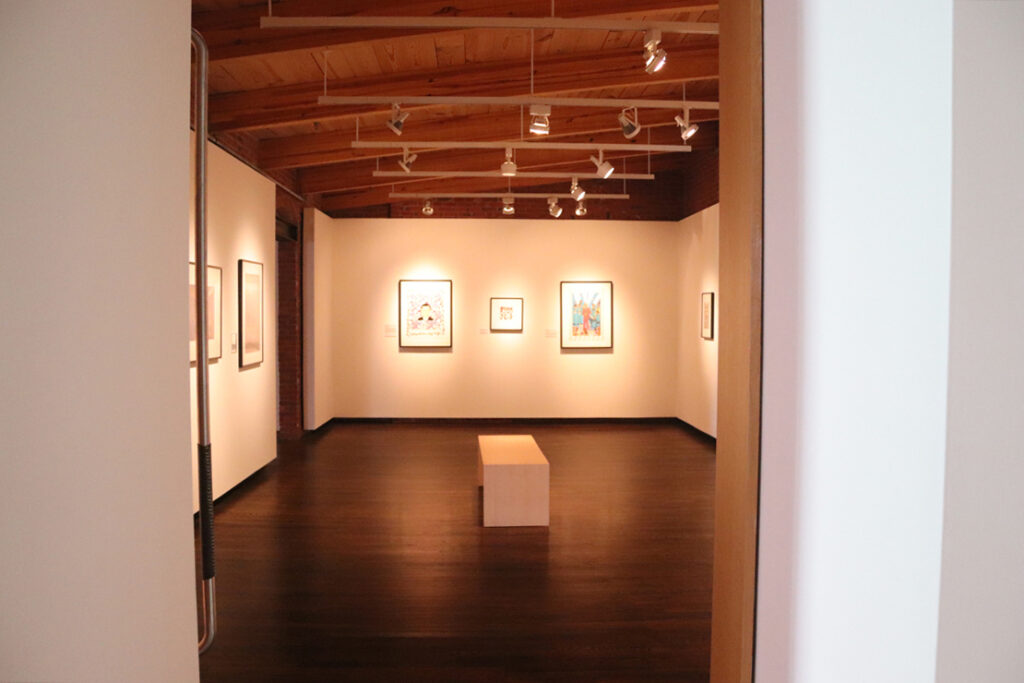
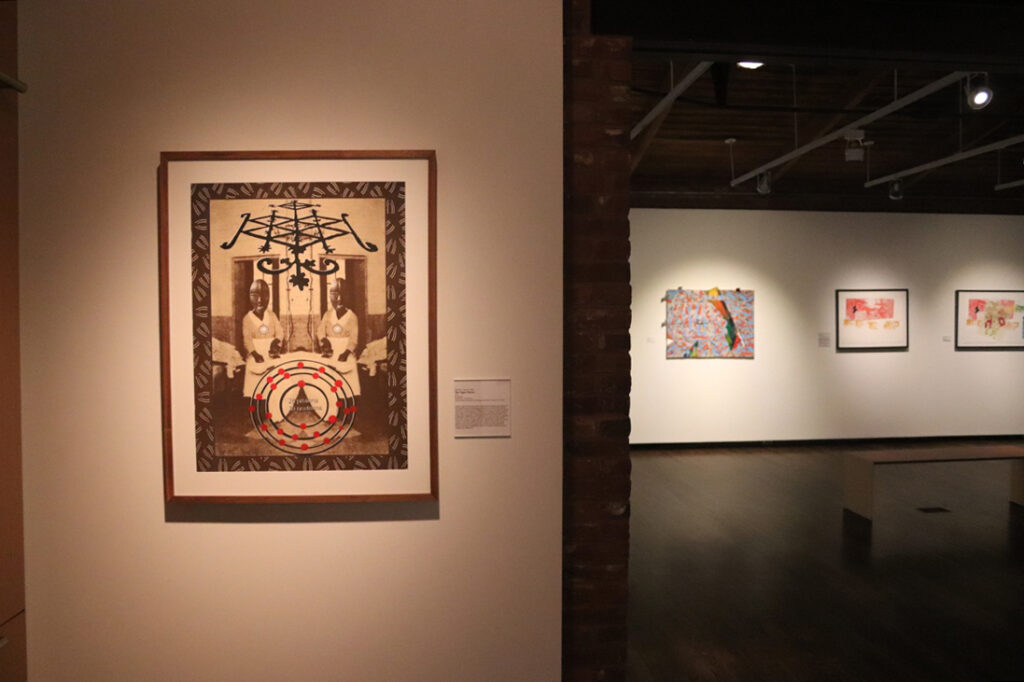
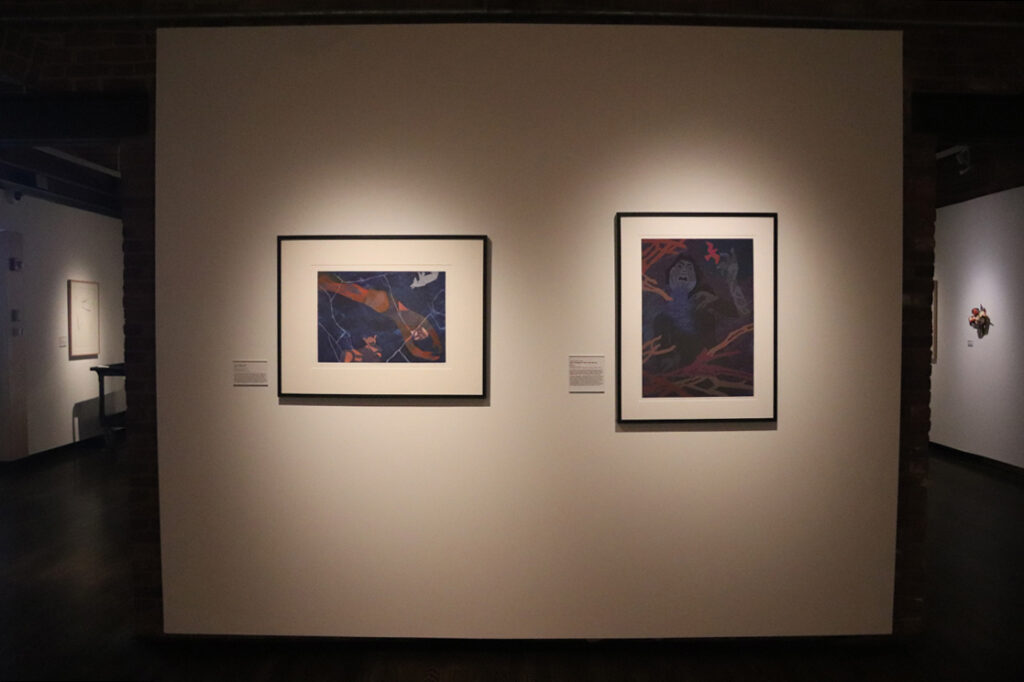
20.
Willie Cole (b. 1955)
The Ogun Sisters
2012
Serigraph
Museums Collections, Gift of Experimental Printmaking Institute, Lafayette College
Holton’s gift of fifty-four prints honoring the twenty-year history of the Experimental Printmaking Institute has enriched the existing collection of works by EPI-affiliated artists, but it has also introduced new artists to the Museums’ collections. A sculptor and conceptual artist, Willie Cole is best known for assembling found objects into imaginative installations and public works of art. He was in residence at the EPI in 2012 and 2013, where he produced The Ogun Sisters. The print’s border is patterned with a design that recalls iron scorch marks, a common motif in his work. Cole’s art traces the social, political, and cultural perspectives of collective and individual African-American experiences, which he overlays with forms and motifs from African art.
21.
robin holder (b. 1952)
Map of Nubia III
1989
Linoleum print with stencils
Museums Collections, Gift of Robert & Joanne Mitchell
In 1999, the Museums acquired its first print by robin holder, Map of Nubia III, from her “Karnak” series. Inspired by a trip to Egypt, the prints in this series layer semi-transparent and opaque images of ancient Pharonic symbols and flying figures, who represent how we move in and around our individual and collective memories. The floating, falling figure in Map of Nubia III alludes to the artist’s interest in passage – the passage of a soul from life to death and the passing on of history and knowledge from one generation to the next.
22.
robin holder (b. 1952)
They Damaged Us More than Katrina
2006
Serigraph
Museums Collections, Gift of Experimental Printmaking Institute, Lafayette College
In 1999, the Museums acquired its first print by robin holder, Map of Nubia III, from her “Karnak” series. Inspired by a trip to Egypt, the prints in this series layer semi-transparent and opaque images of ancient Pharonic symbols and flying figures, who represent how we move in and around our individual and collective memories. The floating, falling figure in Map of Nubia III alludes to the artist’s interest in passage – the passage of a soul from life to death and the passing on of history and knowledge from one generation to the next.
holder turns our attention to images of feminine energy and power with her series “Warrior Women Wizards: Mystical Magical Mysteries,” which includes nearly forty images of women in various states of empowerment. They Damaged Us More Than Katrina, a print that holder made during her residency at the EPI in 2006, evokes the destruction caused by Hurricane Katrina in 2005 and the trauma of the delayed and insufficient government response. The figure cries out in anguish, her hands clenched, but her body fills the composition as she looks up towards birds that soar as symbols of hope and elation. In 2009, holder described the series as “an ongoing exploration of the internal infrastructure that serves as my spiritual armature. The images unveil the memories, visions, hopes, rage, anguish, and thanksgivings that are etched on my soul.”[4]
[4] “Warrior Women Wizards: Mystical Magical Mysteries,” from Robin Holder’s Mid-Career Retrospective, an online catalogue published in conjunction with the exhibition curated by and presented at the David C. Driskell Center for the Study of the Visual Arts and Culture of African Americans and the African Diaspora at the University of Maryland, College Park, MD.
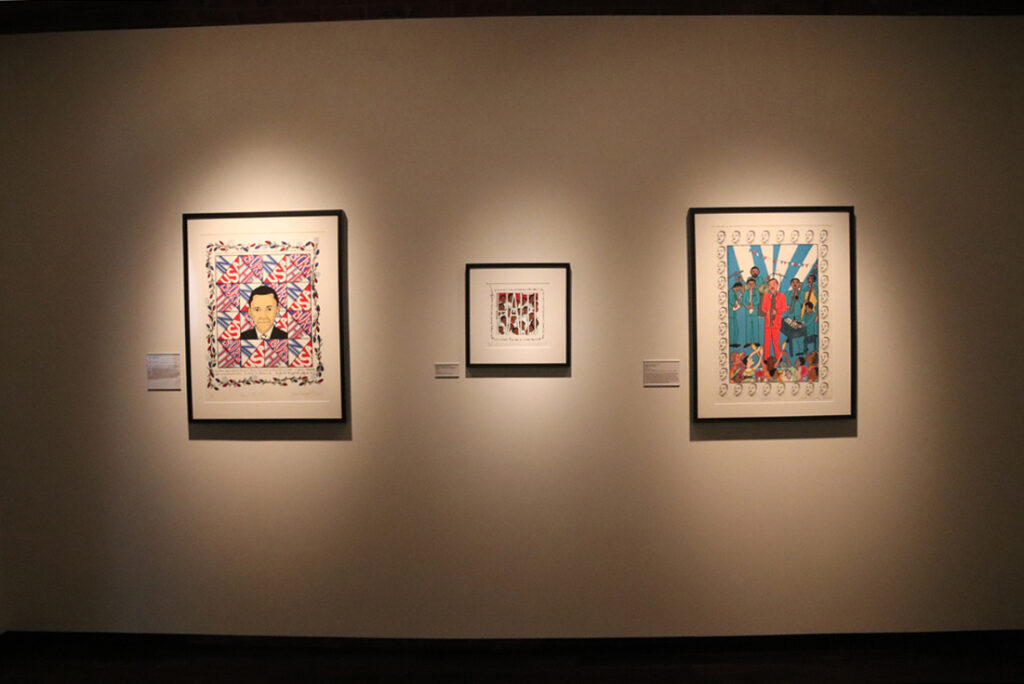
23.
Faith Ringgold (b. 1930)
Born in the USA
2012
Serigraph
Museums Collections, Gift of Experimental Printmaking Institute, Lafayette College
Born in the USA was first produced in 2011 and predicts Barack Obama’s re-election for a second term as President of the United States in 2012. The election was won by a significant margin, despite the circulation of conspiracy theories about President Obama’s birthplace. Ringgold’s print reinforces the significance of his presidency through the inscriptions above and below the image that refer to “the first Black President of the USA.” The legitimacy of his presidency is reaffirmed through the repeated insistence of a single line of text throughout the image: “Born in the USA.”
In its political content, the print complements Where Do All the Children Go?, a serigraph made in response to the 2010 earthquake that devastated Haiti. Later that year, this print became the first by Ringgold to be accessioned into the Museums’ collection at the University of Delaware. The EPI gift enriched the Museums’ existing collection of work by Ringgold and the two prints paired here exemplify her interest in politically-engaged subject matter.
24.
Faith Ringgold (b. 1930)
Where Do All the Children Go?
2010
Silkscreen
Museums Collections, Purchase
25.
Faith Ringgold (b. 1930)
Wynton’s Tune
2004
Serigraph
Museums Collections, Gift of Experimental Printmaking Institute, Lafayette College
Faith Ringgold was the first artist to collaborate with Curlee Raven Holton at Lafayette College, arriving on campus for the first time in 1993. The 2016 EPI gift highlighted in this exhibition includes seven prints by Ringgold, a significant expansion of the Museums’ collection of works by this important contemporary artist. Wynton’s Tune is part of her Jazz Series, begun in 2002 as a celebration of the creative and collaborative genius of jazz musicians. The print honors one of her favorite performers, Wynton Marsalis.

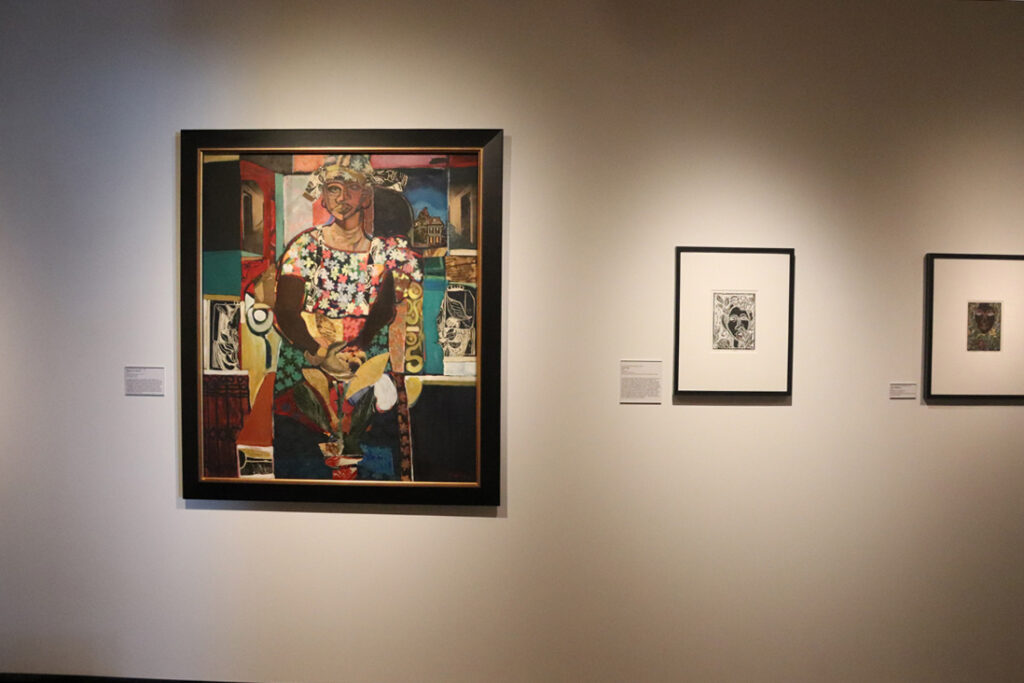
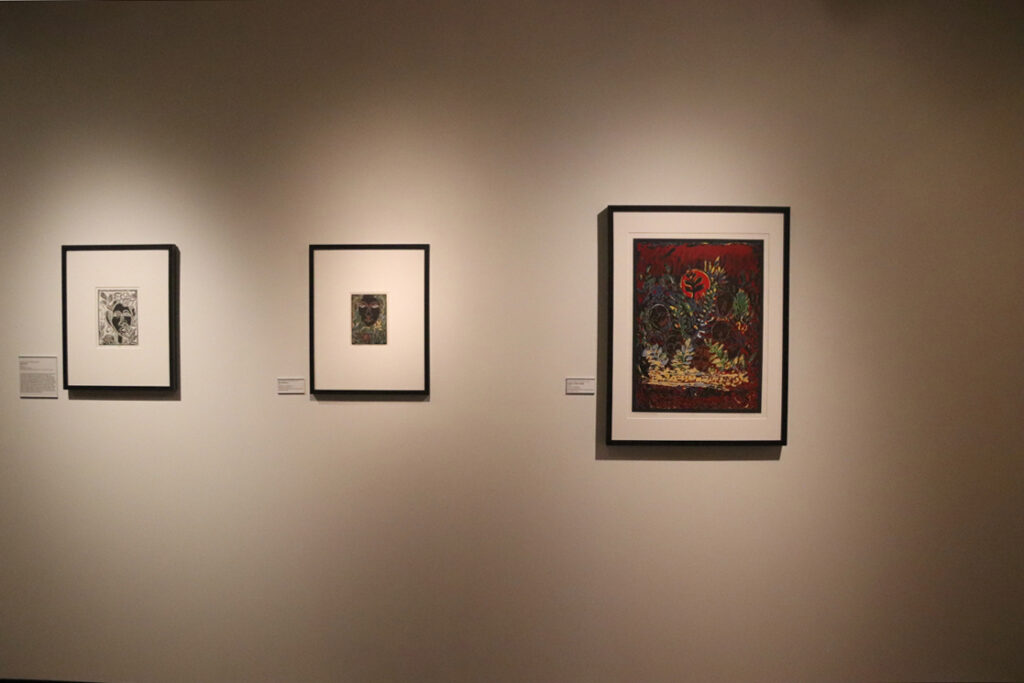
26.
David Clyde Driskell (b. 1931)
The Muse
2014
Relief print
Museums Collections, Gift of Experimental Printmaking Institute, Lafayette College
27.
David Clyde Driskell (b. 1931)
Worker
1972
Assemblage
Museums Collections, Gift of Paul R. Jones
Experimentation with a range of media and techniques has been a hallmark of David Clyde Driskell’s work since the very outset of his career as a painter and printmaker. In the 1970s, he pushed the boundaries of his materials – paint, paper, glue, and found images – to produce assemblages like Worker. In a 2011 interview about this work, Driskell described beginning Worker in December 1972, soon after returning from extensive travel in Africa. He added the image of a woman, a cutout from LOOK magazine, months after he completed the initial painting. At this early phase of his career, Driskell approached experimentation in the studio as an impermanent, additive process.
28.
David Clyde Driskell (b. 1931)
Woman in Interior
1973
Mixed media, collage on canvas
Museums Collections
Gift of Paul R. Jones
In an artist’s statement accompanying a 1974 exhibition that included this large-scale mixed media collage, David Clyde Driskell wrote, “I am still excited about the power of color and what it can do to transform a lifeless two-dimensional surface into an actively forceful form.” The transformative power of color in this work is amplified by the juxtaposition of collaged elements in black and white on either side of the canvas, on the woman’s hat, and extending from her shoulders to her waist. The linearity of these collaged details prefigures Driskell’s later experiments with relief printing techniques at the EPI.
29.
David Clyde Driskell (b. 1931)
Lady Day
2014
Relief print
Museums Collections, Gift of Experimental Printmaking Institute, Lafayette College
As a printmaker, David Clyde Driskell works primarily with woodcut and linocut techniques that suit the persistent linearity of his compositions. During his residencies at the EPI, Driskell embraced a new mode of collaborative experimentation, working alongside other artists to produce distinctive prints that evoke familiar visual vocabularies. The heavy, calligraphic quality of the lines in Lady Day are echoed and then reinforced with color in a print like The Hibiscus. Another print from 2014, The Muse, features an especially shallow plane, a common compositional theme in Driskell’s work.Motifs drawn from nature are at the center of many of his prints, including Dance of the Mask, which he produced at the EPI in 2008. In a 2011 lecture, Driskell remarked, “A wise artist knows that nature is that all-encompassing force that out-paints us all… Nature has been my lover, my guide, my critic, and my refuge.”
30.
David Clyde Driskell (b. 1931)
The Hibiscus
2015
Serigraph and relief print
Museums Collections, Gift of Experimental Printmaking Institute, Lafayette College
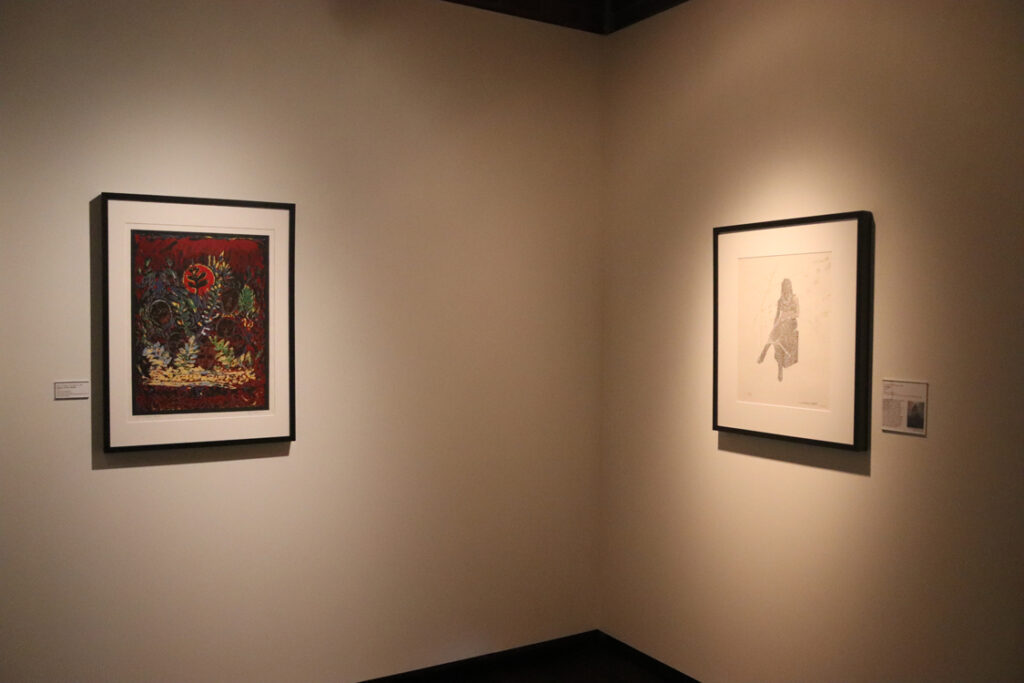
31.
David Clyde Driskell (b. 1931)
Dance of the Mask
2008
Textured serigraph
Museums Collections, Gift of Experimental Printmaking Institute, Lafayette College
32.
Arcmanoro Niles (b. 1989)
Untitled
Monoprint
2012
Museums Collections, Gift of Experimental Printmaking Institute, Lafayette College
Arcmanoro Niles’ work first entered the Museums’ collection with the EPI gift in 2016. In Untitled, Niles uses a single color of ink but manipulates its application to build up the image of a woman sitting, her legs crossed, under the branches of a tree. In 2013, Niles revisited a version of his composition in a large oil painting, Culture’s Mythology. The reversed image of the woman who crosses her legs to her right in the print points to the reversal that results from the monoprint technique Niles employed at the EPI.

